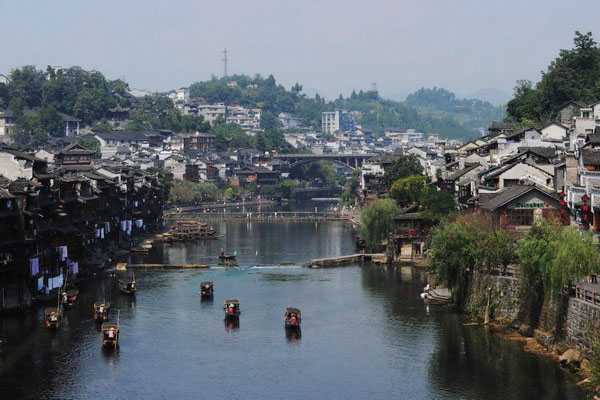Old towns navigate preservation amid development
Updated: 2013-04-18 14:13
(Xinhua)
|
||||||||
|
 A glance at Fenghuang township in Central China's Hunan province. The well-known scenic spot angered local business people by introducing a fee collection policy that authorities claim is meant to better protect the town. [File photo by Liu Debin / Asianewsphoto] |
KUNMING - Old Chinese towns that attract huge numbers of tourists from across the country are caught between a rock and a hard place in pursuing commercial development while preserving their old-style flavor.
Fenghuang township in Central China's Hunan province recently angered local business people by introducing a fee collection policy that authorities claim is meant to better protect the town.
According to the new policy, effective last Wednesday, tourists are required to pay 148 yuan ($23.5) to enter the 300-year-old town renowned for its well-preserved architecture.
Prior to the policy, it was free to enter the town, but tourists were charged 148 yuan for some specific sightseeing spots and 108 yuan for a mountainous scenic spot.
Disgruntled store owners and inn keepers closed their businesses and gathered at a dock on Thursday to protest the policy, which they said would reduce their tourism revenue.
Although the gathering was quickly broken up and order restored, the controversy surrounding the fee collection has been lingering, with some criticizing the local government for seeking economic gain at the cost of public interests.
Cai Long, deputy head of Fenghuang county, however, said the move was mainly aimed at raising money for the protection of the town and curbing the number of tourists.
According to Cai, tourist arrivals to Fenghuang have risen to nearly 7 million annually, about 20 times the county's population. This puts great pressure on the preservation of the town's old-style architecture and long-standing tradition.
Meanwhile, Fenghuang is not alone in collecting exorbitant fees from tourists during the country's tourism craze amid the backdrop of an economic boom, said Yang Fuquan, vice president of the Yunnan Provincial Academy of Social Sciences.
Statistics from the country's tourism authorities show that domestic tourists totalled nearly 3 billion in 2012, a record high that is almost three times the combined population of the United States and European Union.
While some tourists still prefer to visit metropolises like Beijing and Shanghai, others have opted for much quieter places that allow for a brief respite from urban life.
Yang, however, said authorities in these old towns need to do more than just put up a fence and collect fees.
In Yang's hometown, the Old Town of Lijiang, Southwest China's Yunnan province, the local government is trying to strike a balance between preserving the traditional scenery and catering to the demands of tourists.
Unlike Fenghuang, no entry fees are collected in the 800-year-old town covering 3.8 square kilometers.
However, tourists have to pay a maintenance fee when they check in at local inns or hotels for the night, a surcharge that has been more readily accepted.
According to He Hongyang, deputy chief of the ancient town protection bureau of Lijiang city, which administers the old town, about 1.5 billion yuan in such fees has been collected since 2001, while the government has injected 1.8 billion yuan for the protection of the town since 1997, when it was listed as a World Heritage Site by UNESCO.
In the meantime, the government has been soliciting ideas from the public on how to better protect the town and sustain its development in the long run.
At the advice of Internet users, a patrol team resembling the ancient night watchmen, composed of local people and relocated businesspeople, was set up last year to better ensure public security while adding a touch of old flavor to the bustling town.

 Li Na on Time cover, makes influential 100 list
Li Na on Time cover, makes influential 100 list
 FBI releases photos of 2 Boston bombings suspects
FBI releases photos of 2 Boston bombings suspects
 World's wackiest hairstyles
World's wackiest hairstyles
 Sandstorms strike Northwest China
Sandstorms strike Northwest China
 Never-seen photos of Madonna on display
Never-seen photos of Madonna on display
 H7N9 outbreak linked to waterfowl migration
H7N9 outbreak linked to waterfowl migration
 Dozens feared dead in Texas plant blast
Dozens feared dead in Texas plant blast
 Venezuelan court rules out manual votes counting
Venezuelan court rules out manual votes counting
Most Viewed
Editor's Picks

|

|

|

|

|

|
Today's Top News
Boston bombing suspect reported cornered on boat
7.0-magnitude quake hits Sichuan
Cross-talk artist helps to spread the word
'Green' awareness levels drop in Beijing
Palace Museum spruces up
First couple on Time's list of most influential
H7N9 flu transmission studied
Trading channels 'need to broaden'
US Weekly

|

|







